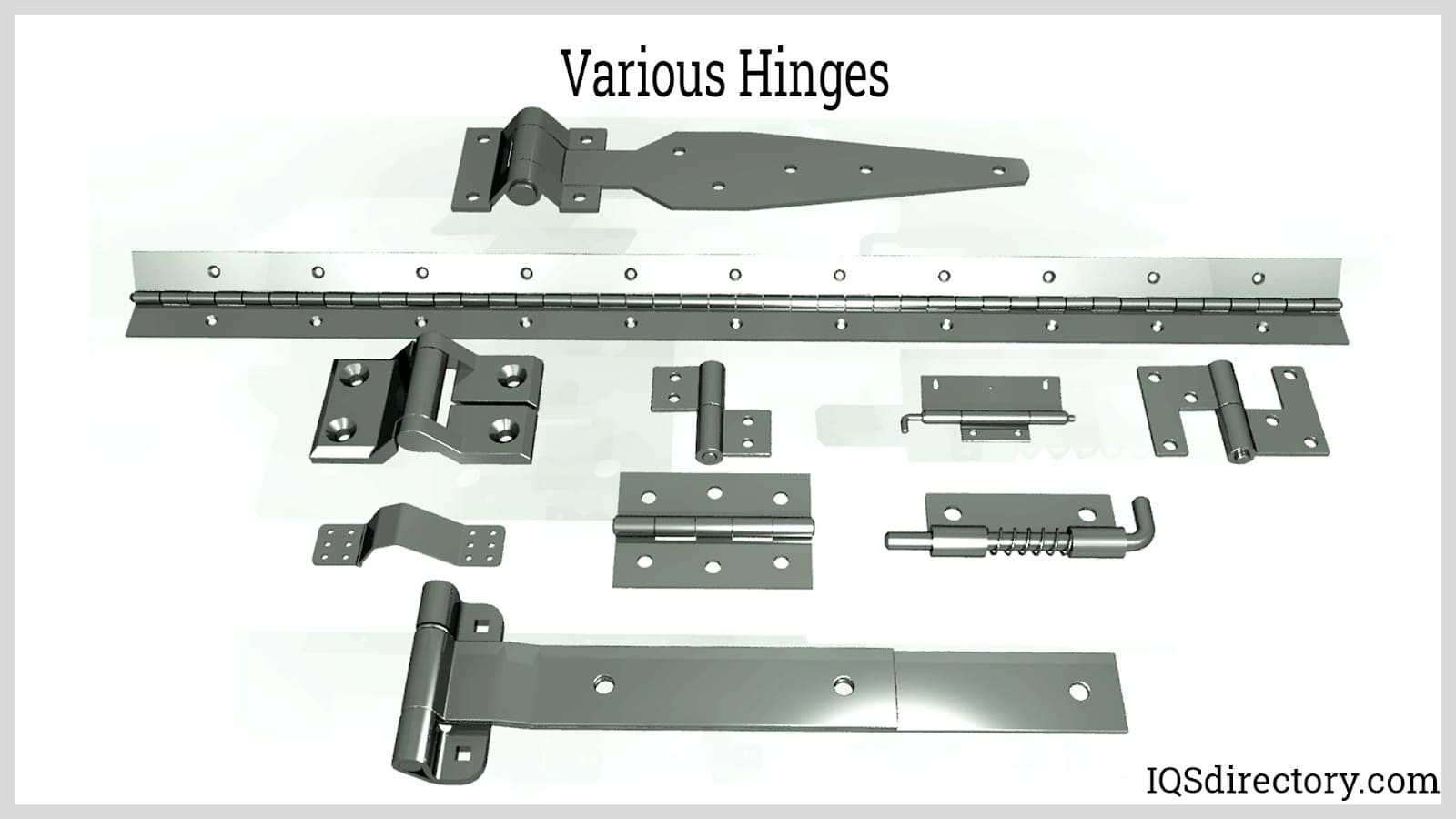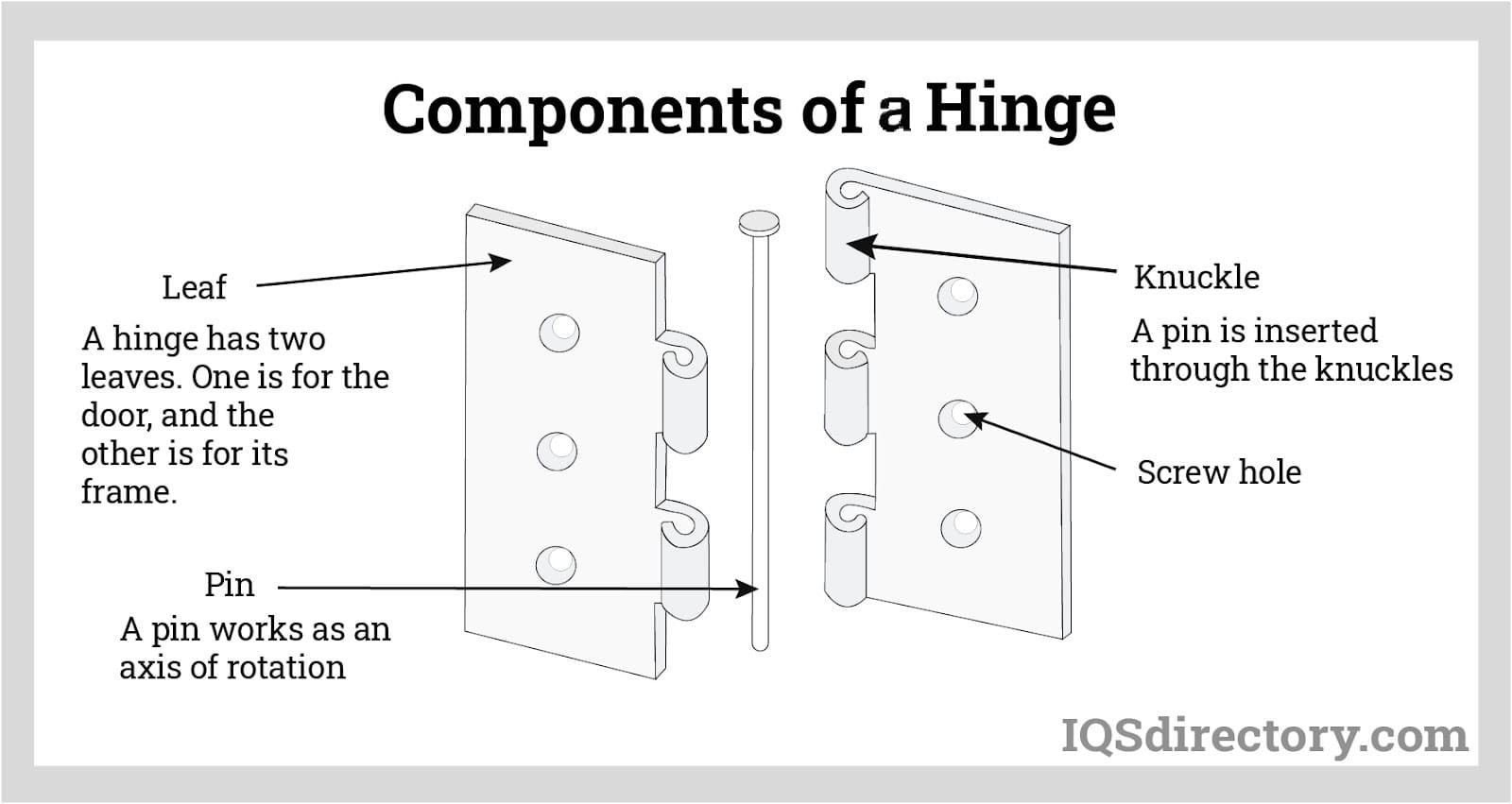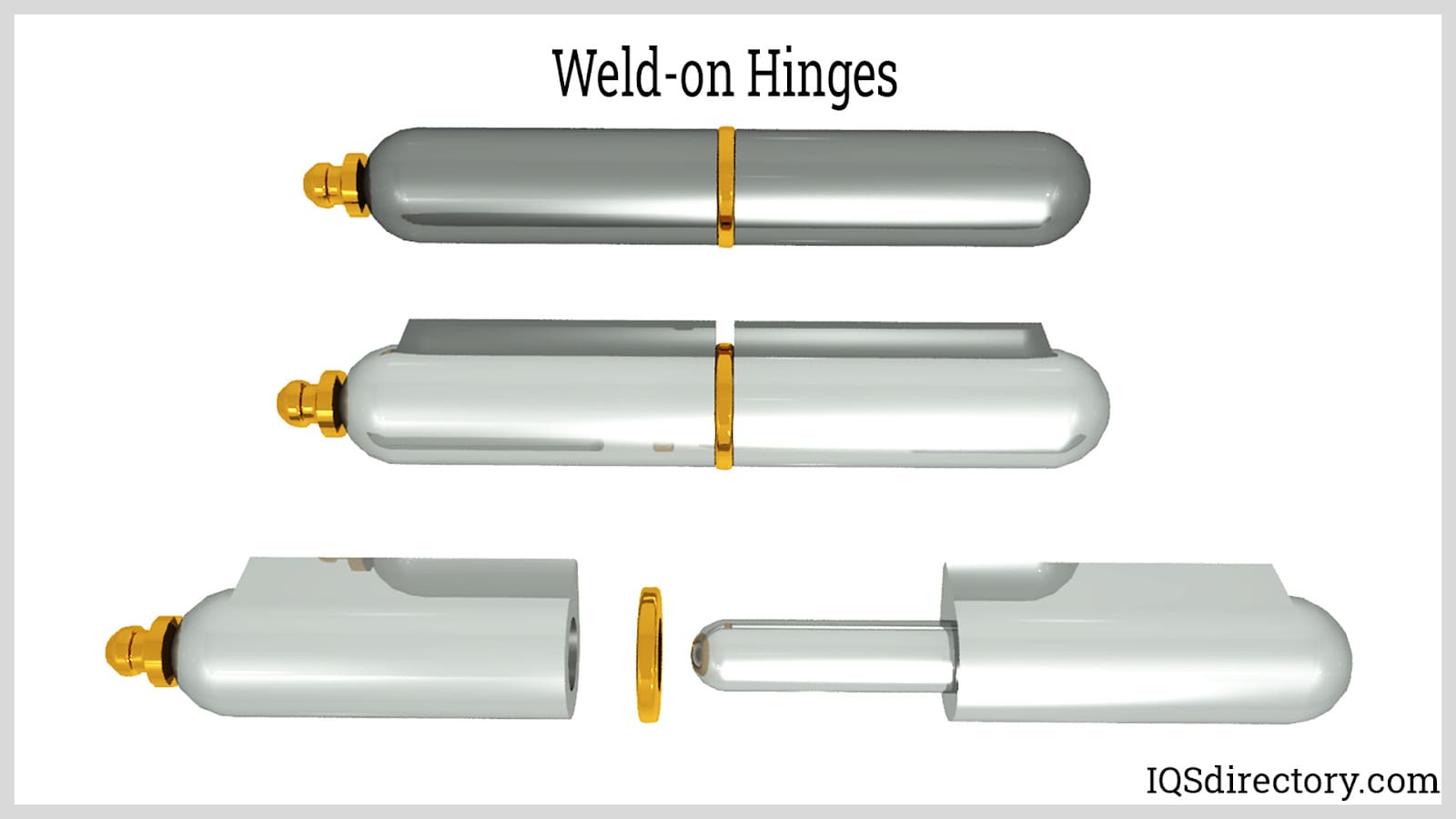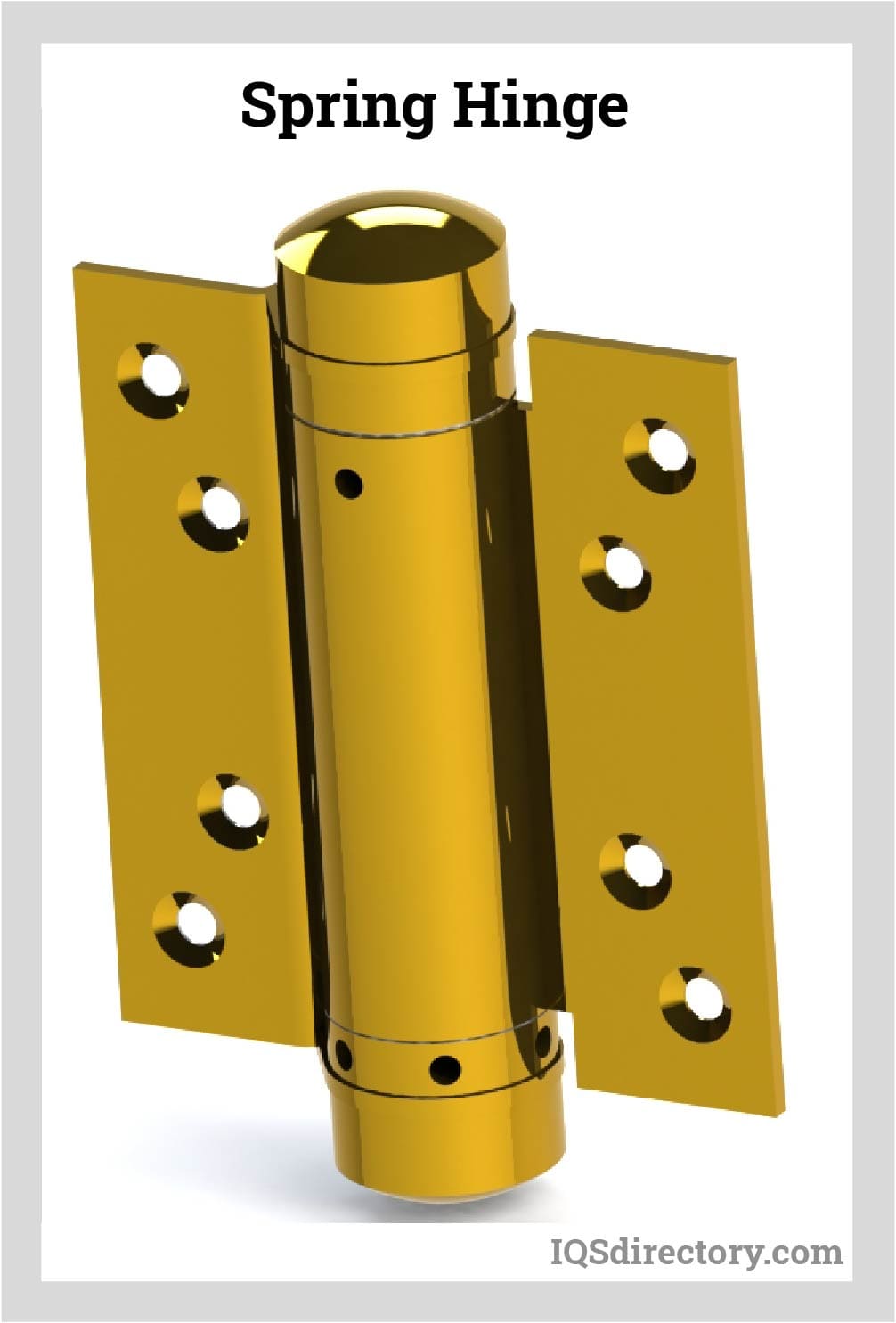Hinges
A hinge is a mechanical bearing designed to connect two objects while enabling controlled movement between them. Once joined, these objects can rotate within a limited angle relative to each other, maintaining their connection without coming apart. This functionality makes hinges essential across numerous applications where stability and movement must coexist.
This versatile hardware is widely utilized across multiple industries, including architecture, commercial and residential construction, jewelry making, furniture and cabinetry, material handling, fencing and barriers, and electronics. Hinges can be found in countless everyday and industrial settings, appearing on doors, storage containers, cabinets, boxes, pianos, cosmetic packaging, gates, tables, laptops, home appliances, lockers, lockets, animal enclosures, and many other products that rely on controlled movement and secure attachment.
Hinge FAQs
What is the basic function of a hinge?
A hinge connects two objects while allowing limited angular movement. It secures components together while enabling smooth rotation, making it essential for doors, cabinets, gates, and industrial equipment.
When were hinges first used in history?
Hinges date back to the Bronze Age, with early examples found at the ancient Hittite capital of Hattusa around 1600 B.C. They were originally used in sacred buildings before spreading to household and industrial uses.
What materials are commonly used to make hinges?
Hinges are typically made from metals such as stainless steel, brass, bronze, copper, chrome, and nickel. Each material offers different benefits in strength, durability, and resistance to corrosion or wear.
What are the main components of a hinge?
A hinge consists of three core parts: leaves, which attach to the surfaces; a pin, which secures the joint; and a knuckle, the cylindrical section that allows smooth pivoting movement between connected objects.
Which types of hinges are used for heavy-duty applications?
Heavy duty hinges and ball bearing hinges are commonly used for demanding applications. They provide high load capacity, durability, and smooth operation, making them suitable for industrial doors, gates, and machinery.
How can hinge durability be improved?
Durability is enhanced through protective coatings such as plating, galvanization, painting, or polishing. Choosing corrosion-resistant metals like stainless steel also helps hinges withstand moisture, abrasion, and outdoor environments.
What standards govern hinge manufacturing in the U.S.?
In the U.S., hinge manufacturing follows ANSI and BHMA standards. These guidelines ensure consistency in quality, durability, and safety, while also supporting accessibility requirements such as ADA compliance for public spaces.
The History of Hinges
Hinges have a long and storied history, dating back thousands of years. While their exact origins remain uncertain, archaeological evidence confirms that they were in use as early as the Bronze Age in the Near and Middle East. Among the earliest known examples are those discovered in Turkey at the site of Hattusa, the ancient capital of the Hittite Empire. Dating back to approximately 1600 B.C., these early hinges were reserved for sacred and significant public buildings. Similarly, references to hinges appear only once in the Old Testament, specifically in relation to King Solomon’s temple. Excavations at ancient Babylonian and Assyrian temple sites have also uncovered hinges, reinforcing the idea that they were used primarily for monumental and religious structures rather than in everyday homes.
As history progressed into the Middle Ages, the accessibility of metal increased, making it more affordable for common use. Blacksmithing became more widespread, allowing hinges to transition from exclusive use in temples and public buildings to everyday applications. People began incorporating hinges into household and practical items, including jewelry boxes, ships, wagons, gates, and locking mechanisms. With the onset of the Industrial Revolution, hinge manufacturing expanded significantly, as hinges became essential components in the rapidly growing world of machinery and mass production. In 1899, Stanley’s Bolt Manufactory, now known as StanleyWorks, patented ball-bearing hinges, marking a major innovation in hinge design. The 20th and 21st centuries have brought even greater advancements, with hinges now enabling gates to swing in both directions and playing integral roles in modern applications such as aircraft, military vehicles, computing devices, and more.
Hinge Design
The manufacturing of hinges begins with heating raw metal materials and shaping them through a variety of machining processes. Some of the most commonly used techniques include casting, extrusion, cutting, and deformation. The specific process chosen depends on factors such as production speed, volume requirements, design complexity, and budget constraints.
Once the basic shape has been formed, manufacturers often apply secondary finishing processes to enhance durability and aesthetics. These may include smoothing, rust-proofing, plating, galvanization, painting, polishing, or coating. Such treatments are particularly important for hinges, as they experience constant movement and exposure to wear, abrasion, and corrosion. Hinges used in outdoor or high-moisture environments are especially vulnerable to deterioration, making protective coatings essential to extend their lifespan.
Hinges can be constructed from a variety of materials, most commonly solid or hollow metals. Popular choices include copper, brass, nickel, bronze, stainless steel, chrome, and steel, each offering unique properties in terms of strength, resistance to corrosion, and visual appeal.
Most hinges consist of three fundamental components: leaves, a pin, and a knuckle. The leaves are flat plates that extend outward from the hinge and serve as attachment points for the connected surfaces. The pin, inserted into the knuckle, secures the leaves together and enables movement. The knuckle itself functions as the joint, typically cylindrical and hollow, allowing the hinge to pivot smoothly. These three elements form the core of a hinge’s design, but beyond this, hinges can be tailored in countless ways to meet specific needs.
Customization options for hinges are virtually limitless. They can feature decorative finishes for an elegant aesthetic or be completely concealed within the objects they join. Manufacturers can produce hinges in any color and apply specialized coatings to match their intended environment. Depending on the application, hinges may be long and continuous for structural reinforcement or small and discreet for compact, intricate assemblies. Whether enhancing a grand architectural feature or ensuring the seamless operation of a laptop, hinges remain one of the most essential and adaptable mechanical components in the modern world.
Hinge Images, Diagrams and Visual Concepts
 Hinges connects two bodies allowing angular movement about a fixed axis of rotation, all the while preventing translations and rotations on the remaining two axes.
Hinges connects two bodies allowing angular movement about a fixed axis of rotation, all the while preventing translations and rotations on the remaining two axes.
 Hinges have limited movement, allowing the joint to move only at one angle and restrict the other movements of swinging parts.
Hinges have limited movement, allowing the joint to move only at one angle and restrict the other movements of swinging parts.
 THe different components of a hinge to allow motion.
THe different components of a hinge to allow motion.
 Weld-on hinges uses metal enclosures or gates where the hinge is needed to be fixed permanently through welding.
Weld-on hinges uses metal enclosures or gates where the hinge is needed to be fixed permanently through welding.
 Friction hinges are designed which allows for them to maintains the desired position for extended periods of time.
Friction hinges are designed which allows for them to maintains the desired position for extended periods of time.
 Spring hinge, a self-closing hinge that automatically closes two connected workpieces using the action of a spring that is loaded in the hinge's barrel.
Spring hinge, a self-closing hinge that automatically closes two connected workpieces using the action of a spring that is loaded in the hinge's barrel.
Hinge Types
- Ball Bearing Hinges
- Designed for high-frequency applications, particularly for indoor use and doors equipped with closers. Their smooth operation and durability make them ideal for environments requiring frequent door movement.
- Bronze Bearing Hinges
- Excel in outdoor and harsh environments due to their resistance to corrosion and extreme conditions, ensuring longevity in exposed settings.
- Butt Hinges
- Attach securely to both the door and the door frame, allowing for smooth swinging movement. They are commonly used for standard swinging doors in residential and commercial spaces.
- Cabinet Hinges
- Must be constructed from strong, heavy materials to maintain the proper alignment of cabinet doors, preventing sagging or misalignment over time.
- Continuous or Piano Hinges
- Extend longer than standard hinges, often measuring five inches or more. Their continuous length provides consistent strength along the entire hinge, reinforcing structural support and minimizing gaps between connected objects.
- Door Hinges
- Versatile and used across a variety of settings, from personal and office spaces to industrial environments, ensuring seamless operation of doors in different applications.
- Friction Hinges
- Unique combination of fluid motion and rigid positioning, allowing objects to move smoothly while maintaining a set position without additional support.
- Gate Hinges
- Specifically designed for use on gates and entryways. They are available in both manual and automatic configurations, offering convenience and security for residential, commercial, and industrial applications.
- Heavy Duty Hinges
- Stand out for their exceptional performance and ability to support heavy loads, making them essential for demanding environments requiring durability and strength.
- Hidden Hinges
- Function seamlessly while remaining concealed from view. These hinges are installed in a way that ensures no visible hardware when the attached objects are in use, enhancing aesthetic appeal.
- Multiple Pin Hinges
- Incorporate more than one pin, making them ideal for double-action movement, ensuring smooth operation in specialized applications.
- Panel Hinges
- Specifically designed for doors that are flush-set into a frame, providing a clean and cohesive appearance while maintaining functionality.
- Plain Bearing Hinges
- Serve a wide range of applications that require light to moderate usage, offering a simple yet effective solution for everyday hinge needs.
- Plastic Hinges
- Distinct advantages, such as rust resistance, silent operation, and the elimination of lubrication requirements. They are more cost-effective than metal hinges and are often UV, chemical, and heat resistant, making them suitable for diverse environments.
- Pull Handles
- Functional hardware components that allow users to pull or grip objects for movement. Common variations include industrial handles, grip handles, grab handles, door handles, cabinet handles, tubular handles, and drawer pulls, all essential in everyday applications.
- Slip Hinges
- Widely used in applications where removable doors and lids are necessary. Their versatility stems from the ability to be manufactured from various materials, making them adaptable across industries.
- Spring Hinges
- Designed for entryways that require automatic closure. These spring-loaded hinges can also be configured for automatic opening, making them ideal for self-closing doors and gates.
- Small Hinges
- Connect two pieces while allowing movement, with some designs serving as decorative elements on tool kits, cabinets, and fine furniture.
- Stainless Steel Hinges
- Highly resistant to oxidation and corrosion, making them the preferred choice for marine, oil and gas, petrochemical, chemical, and pharmaceutical applications where durability is critical.
- Standard Cut Off Hinges
- Feature an even number of full knuckles. When positioned upright, a knuckle appears on the left end while a notch is present on the right end of the lower leaf, ensuring precise alignment.
- Stop Hinges
- Incorporate built-in movement limitations, restricting the angle of rotation to prevent overextension or damage.
- Strap Hinges
- Distinguished by their long straps that attach to the face of doors and cabinets, both interior and exterior. These hinges enable up to 180 degrees of swinging movement, ensuring flexibility and stability.
- Weld On Hinges
- Compact yet robust, connecting two separate metal parts—such as doors and frames—without the use of knuckles, offering a strong, permanent solution for metal-based assemblies.
Features of Hinges
Hinges function with remarkable simplicity. Once installed, they allow the attached moving component—such as a door—to pivot smoothly while remaining securely connected to a stationary component, like a door frame. By simply pushing or pulling, the user can engage the hinge’s movement, facilitating effortless operation.
Despite their wide variety, hinges share a set of defining characteristics that influence their performance and functionality. End play refers to axial movement between the leaves along the pin’s axis. Gauge describes the thickness of the leaves, while hinge width measures the distance from the outer edge of one leaf to the outer edge of the other. Hinge length runs parallel to the pin, determining the overall size of the hinge. Knuckle length represents the size of each individual knuckle along the pin’s axis, while leaf width is the distance from the pin’s center to the outer edge of the leaf. Pitch measures the spacing between knuckles on the same leaf, and slop refers to any loose angular movement of the leaves relative to the pin. Each of these attributes contributes to the hinge’s overall strength, flexibility, and fit within its intended application.
Hinges offer a superior alternative to simpler mechanisms like slides because they ensure that connected components remain securely attached while allowing controlled movement. Unlike slides, which only permit linear motion, hinges enable movement in two directions, enhancing their versatility across numerous applications.
Hinge Standards and Specifications
To ensure consistency, durability, and quality, manufacturers should adhere to ANSI (American National Standards Institute) and BHMA (Builder’s Hardware Manufacturing Association) standards when designing and producing hinges. These nationally recognized standards establish guidelines for materials, durability, safety, security, sustainability, and appearance. By following these standards, manufacturers promote interchangeability and compatibility, making hinge replacement and installation more efficient across industries.
Additional standards vary depending on the specific industry, application, and regional regulations. For example, certain hinges—such as those used for gates—must comply with ADA (Americans with Disabilities Act) requirements to ensure accessibility. This means they must be designed for wheelchair accessibility or adapted to accommodate individuals with limited mobility, ensuring inclusivity in public and private spaces.
Things to Consider When Purchasing a Hinge
To ensure you get the best performance from your hinge, carefully evaluate factors such as your application’s requirements, the frequency of use, industry regulations, and aesthetic preferences. Additionally, consider the hinge’s placement, the appearance you want to achieve, and the size, weight, and shape of the objects it will connect. These details will influence the hinge’s durability, functionality, and overall fit for your specific needs.
Once you have identified your requirements, selecting the right hinge manufacturer is essential. While many reputable manufacturers are available, the right one for you will take a customer-specific approach, tailoring their services to meet your unique needs. A quality manufacturer will listen attentively to your requests, factor in your budget, and work diligently to accommodate your specifications. Whether you need a standard hinge or a customized specialty solution, the right manufacturer will provide the best options to suit your application.
For additional information about a particular company, simply hover your mouse over their name and click the image that appears on the right-hand side. You can also navigate to the top of this page to find a conveniently organized list of hinge manufacturers.
Installation of a Hinge
While installation methods vary depending on the hinge type and the surface it is being attached to, the general process is straightforward. The most basic installation method involves a few key steps. First, align your hinges and determine the correct screw placement. Mark or drill these spots as needed. Secure one leaf by drilling in the screws, ensuring proper alignment with the pin and knuckle. Once in place, insert the pin and secure the second leaf by drilling it into position.
Some hinges require additional preparation and more precise installation techniques. For complex applications, it is essential to familiarize yourself with the correct procedure before beginning. Consulting with your hinge manufacturer or supplier can provide valuable guidance, ensuring proper installation and optimal hinge performance.
Proper Care for Hinges
Ensuring the longevity and continued performance of your hinges requires proper care and maintenance. Fortunately, keeping them in optimal condition is a simple process.
For industrial hinges, high-use hinges, or those exposed to harsh environments, regular lubrication is essential. The most effective method is to remove the pin, apply lubricant generously and directly to it, and then reinstall it. This keeps the hinge operating smoothly and reduces wear over time.
To remove dirt or dust buildup, wipe the hinge with a damp cloth. It is best to use only water to prevent any potential chemical reactions with the hinge material. If you encounter sagging or damaged screw holes, reattaching the hinge with carpenter glue can help reinforce the structure and restore stability.
For maximum efficiency and durability, hinges should be resistant to rust, abrasion, and corrosion. The best way to achieve this is by making the right material and finishing choices before installation. Opting for corrosion-resistant metals like stainless steel or applying protective coatings, plating, or paint can significantly extend the lifespan of your hinges, especially in demanding environments.
Hinge Accessories
Hinge sets can be customized with a variety of accessories, ranging from functional enhancements to decorative elements. Some common examples include angle restriction clips, stainless steel eye bolts, compact adaptors, door cushions, doorstops, and tip-on touch latches.
Choosing the right hinge accessories depends entirely on your application. For instance, touch latches are an excellent addition to cabinet hinges, allowing for a sleek, handle-free design. With these, a gentle push on the cabinet door releases the latch, causing the door to open effortlessly. Whether for convenience, safety, or aesthetic appeal, selecting the appropriate accessories can enhance both the functionality and visual appeal of your hinges.
Hinge Terms
- Back Angle
- The angle formed by the hinge leaves when fully open, typically a minimum of 270 degrees.
- Bent Pin
- A hinge pin with a bent end, designed for easy removal.
- Both Leaves Half Swaged
- A configuration where both leaves are swaged to half the pin diameter, creating a small space between them when closed.
- Closed
- The position where the hinge leaves are parallel and touching, aligning at the 0-degree position.
- Coined Pin
- A pin with a deformed end, which allows it to wedge into place when driven into the hinge.
- Crimped Ends
- Hinge pins that are permanently secured due to the depression of the hinge knuckle, preventing removal.
- Detent
- A mechanism that locks the hinge in the open position.
- End Play
- The degree of axial movement allowed between the hinge leaves.
- Flat
- The position where the hinge leaves are fully extended to 180 degrees.
- Gauge
- The thickness measurement of the hinge leaf.
- Hinge Length
- The measurement running parallel to the hinge pin, extending from one end of the leaves to the other.
- Hinge Width
- Also referred to as "open width," it is the measurement perpendicular to the hinge pin, accounting for both leaves and the pin.
- Knuckle
- Also known as the joint, node, curl, or loop, it is the individual, hollow section of a hinge through which the pin is inserted.
- Knuckle Length
- The measurement of an individual knuckle, equivalent to half of the pitch.
- Leaf
- The component of a hinge that extends laterally from the knuckle and rotates around the pin.
- Leaf Width
- The distance from the pin to the outer edge of the leaf.
- Lock Punch
- A process that prevents leaf rotation by displacing material from adjacent knuckles to remove end play. This is located at the bottom of the knuckle in a consistent pattern.
- Offset
- A manufacturing process that reduces leaf width by forming the leaves away from the center of the hinge pin.
- One Leaf Full Swaged
- A configuration in which one leaf is swaged to match the pin diameter, ensuring both leaves remain parallel when closed.
- One Leaf Half Swaged
- A setup where one leaf is swaged to half the pin diameter.
- Opposite Standardd Cutoff
- A hinge design where the lower leaf features a left-end notch and three knuckles.
- Paint Clearance
- The space maintained between the knuckle and the leaf edge at all hinge positions during operation.
- Pin
- A rod inserted through the hinge knuckles, securing the hinge assembly.
- Pitch
- The distance between the outer ends of two adjacent knuckles.
- Plain Assembly
- A hinge configuration in which the leaves are not swaged, allowing them to lay flat in the same plane when open.
- Reverse Assembly
- A design where the leaves are not swaged, causing them to extend laterally from opposite sides of the pin. In this configuration, the leaves do not close to a parallel position.
- Reverse Swaged
- A variation of reverse assembly where one leaf is swaged, preventing the leaves from closing into a parallel position.
- Side Play
- The extent of movement the hinge leaves have perpendicular to the pin.
- Spun Pin
- A hinge pin that undergoes cold forming at the ends, expanding its diameter beyond the inside portion to prevent axial movement. This method is often used for tamper-proofing.
- Spun Ends
- Hinge pin ends that are peened or flattened to prevent removal. If both ends are spun, the pin is non-removable; however, a pin with only one spun end can still be taken out.
- Staked Pin
- A hinge pin that is permanently secured by staking the hinge's backside, making removal impossible.
- Standard Cutoff
- A hinge design featuring an even number of full-length knuckles, applicable only in plain assembly.
- Stop Hinge
- A hinge designed to restrict the movement of the leaves to a specific angle.
- Stop Hinge, Inside
- A stop hinge where the leaves open up to a designated angle and stop.
- Stop Hinge, Outside
- A stop hinge where the leaves move outward to a specified angle before stopping.
- Swaging
- A process used to adjust hinge leaf width by forming the leaves either toward or away from the hinge pin center.
- Welded Pin
- A type of hinge pin with a splined portion slightly larger than the inside diameter of the pin curl, commonly used in slip joint hinges for added security.